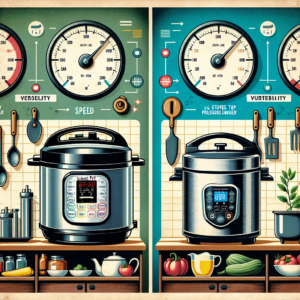Should I Use Natural Release Or Quick Release: Introduction
In the realm of pressure cooking, one question often stirs up a culinary debate: should I use natural release or quick release? It’s a dilemma that many home cooks face, unsure which method will yield the best results for their dish. Natural release, the slower of the two, allows the pressure to naturally dissipate while quick release utilizes a valve to rapidly release the pressure. Both techniques have their merits, but understanding when to use each can make all the difference in creating a perfectly cooked meal.
Pressure Cooking Basics
When it comes to pressure cooking, there are two essential methods for releasing the pressure once your food is cooked: natural release and quick release. Understanding these methods and knowing when to use each one can greatly enhance your pressure cooking experience. In this article, we will delve into the details of how these release methods work, their benefits, and factors to consider when deciding which method to use. Let’s get started!
Understanding Natural Release
Definition of natural release
Natural release is a method of releasing pressure in a pressure cooker by allowing the built-up pressure to dissipate naturally over time. This means that once your food is cooked, you simply turn off the heat and let the pressure cooker sit until the pressure drops on its own. It requires no intervention from you and is a hands-off approach to pressure release.
How natural release works
As the pressure cooker is turned off, the heat source is removed, and the pressure inside begins to decrease gradually. The pressure release valve remains closed during this process, allowing the pressure and steam to escape slowly through the natural vents in the pressure cooker lid. The length of time it takes for the pressure to fully release depends on various factors, such as the recipe, the contents of the pressure cooker, and the size and type of your pressure cooker.
Benefits of natural release
One of the key benefits of natural release is that it helps to retain the natural moisture and tenderness of the food. Since the pressure is gradually released, there is less risk of overcooking delicate ingredients. Natural release also allows flavors to meld and develop further during the resting period, resulting in a more delicious and well-rounded product.
Understanding Quick Release
Definition of quick release
Quick release, also known as manual release or rapid release, is a method of releasing pressure in a pressure cooker by manually manipulating the pressure release valve. It involves opening the valve to quickly and forcefully release the built-up pressure and steam from the cooker.
How quick release works
To perform a quick release, you need to carefully move the pressure release valve to the “Venting” or “Quick Release” position. This action allows the steam to escape rapidly, reducing the pressure inside the cooker within a matter of seconds. It is important to exercise caution when performing a quick release, as the hot steam can cause burns if not handled properly.
Benefits of quick release
Quick release is ideal for time-sensitive recipes or when you need to stop the cooking process immediately. It allows for a quicker release of pressure and helps to expedite the cooling down of the food. This can be particularly useful for ingredients that are prone to overcooking, such as vegetables or seafood. Additionally, quick release can be helpful when you want to halt the cooking and prevent further softening of the food’s texture.
Should I Use Natural Release Or Quick Release: Factors to Consider
When deciding between natural release and quick release, there are several factors you should take into consideration.
Type of recipe
Certain recipes may require a specific method of pressure release. Some recipes, particularly those containing meat or tough cuts, benefit from a natural release as it allows the fiber to relax and become more tender. On the other hand, recipes with delicate ingredients like fish or lightly steamed vegetables may require a quick release to prevent overcooking.
Time sensitivity
Consider the time sensitivity of the recipe and your schedule. If you’re in a rush and need the food to be ready quickly, a quick release can save you valuable time. However, if you have the luxury of allowing the pressure to release naturally, the extra time can contribute to enhanced flavor development.
Ingredient texture
The desired texture of your cooked ingredients also plays a role in determining the appropriate release method. Natural release helps to preserve the tenderness and juiciness of meats and other ingredients, while quick release can help maintain the firmness and crispness of vegetables.

Natural Release Techniques
There are three common natural release techniques: full natural release, partial or intermittent natural release, and a resting period before manual release.
Full natural release
In a full natural release, you simply turn off the heat source, leave the pressure cooker undisturbed, and allow the pressure to decrease naturally until the float valve drops and all pressure is released. This method is suitable for most recipes and ensures thorough cooking and flavor infusion.
Partial or intermittent natural release
Partial or intermittent natural release involves allowing the pressure to release naturally for a certain period, then manually opening the pressure release valve to speed up the process. This technique can be useful when you want to control the pressure release more precisely or when the recipe requires specific pressure intervals.
Resting period before manual release
After turning off the heat, some recipes recommend waiting for a resting period before manually releasing the remaining pressure using quick release. This resting period allows the food to settle and absorb flavors further, contributing to enhanced taste and texture.
Quick Release Techniques
There are three primary quick release techniques: immediate quick release, controlled quick release, and using a kitchen utensil for quick release.
Immediate quick release
Immediate quick release involves moving the pressure release valve to the “Venting” or “Quick Release” position immediately after turning off the heat. This method releases the pressure rapidly and should be done with caution, keeping your hands and face away from the steam vent.
Controlled quick release
Controlled quick release is achieved by turning the pressure release valve to “Venting” or “Quick Release” for short bursts, rather than fully opening it. This technique helps to regulate the speed at which the pressure is released and prevent excessive splattering or spewing of hot liquid.
Using a kitchen utensil for quick release
An alternative method for quick release is using a long-handled utensil, such as a wooden spoon, to move the pressure release valve. This provides an extra level of distance and safety, minimizing the risk of burns from the hot steam.

Comparison of Natural Release and Quick Release
To better understand the differences between natural release and quick release, let’s compare them based on a few key factors.
Effect on food texture
Natural release has the advantage of allowing the food to gently cook and continue releasing moisture, resulting in a tender and succulent texture. On the other hand, quick release stops the cooking process abruptly, preserving a firmer texture in ingredients that are more prone to becoming mushy or overcooked.
Preservation of nutrients
Since natural release prevents excessive heat and pressure, it helps to retain more vitamins, minerals, and nutritional value in the food. Quick release, while faster, may lead to some nutrient loss due to the rapid change in temperature and pressure.
Cooking time
Natural release takes longer than quick release, as it relies on the gradual reduction of pressure over time. If you’re short on time, quick release offers the advantage of a faster cooking process.
Safety considerations
Both natural release and quick release have their own safety considerations. Natural release requires patience and careful monitoring to ensure that the pressure has fully dissipated before opening the lid. With quick release, it is vital to be cautious and avoid direct contact with the steam to prevent burns.
Choosing the Right Method
When it comes to choosing between natural release and quick release, there are a few factors to consider.
Consider recipe requirements
Carefully read through the recipe instructions to determine if there is a preferred or recommended method of pressure release. Some recipes may explicitly state which method yields the best results for the particular dish.
Personal preference
Experiment with both natural release and quick release to determine which method you prefer based on the texture and flavor outcomes. Some individuals enjoy the delicate tenderness achieved through natural release, while others prefer the firmness and vibrancy preserved by quick release.
Time constraints
Evaluate your schedule and the urgency of the meal. If you’re pressed for time, quick release might be the best option. However, if you have the luxury of allowing the pressure to release naturally, it can lead to more developed flavors.
Experimentation
Don’t be afraid to experiment and find what works best for you and your recipes. Every pressure cooker and personal preference can vary, so embrace the opportunity to try different methods and adjust them to suit your needs.
Tips and Best Practices
To make the most of your pressure cooking experience, here are some tips and best practices to keep in mind:
Follow recipe instructions
Always refer to the recipe instructions provided with your pressure cooker for specific guidance on the recommended pressure release method. Every recipe may have unique requirements based on the ingredients and desired outcome.
Use caution with quick release
When performing a quick release, be extremely careful and mindful of the hot steam. Protect your hands and face by keeping a safe distance from the steam vent to avoid burns.
Allow sufficient time for natural release
If you choose to use natural release, ensure that you leave ample time for the pressure to fully dissipate before opening the pressure cooker. Rushing the process may result in undercooked or unevenly cooked food.
Monitor pressure cooker during release process
Regardless of which method you choose, it’s important to monitor the pressure cooker as it releases pressure. Keep an eye on the float valve and pressure indicators to ensure that the pressure is decreasing as expected and that there are no issues with the release valves or seals.
Conclusion
Natural release and quick release are two essential techniques for safely and effectively releasing pressure in a pressure cooker. Both methods have their merits, and understanding the nuances of each can greatly enhance your pressure cooking results. Whether you opt for the tenderness and enhanced flavors of natural release or the speed and firmness of quick release, the choice ultimately depends on the recipe requirements, time constraints, and personal preferences. Experimentation and careful attention to the process will help you achieve the perfect pressure-cooked meals every time. Happy cooking!




